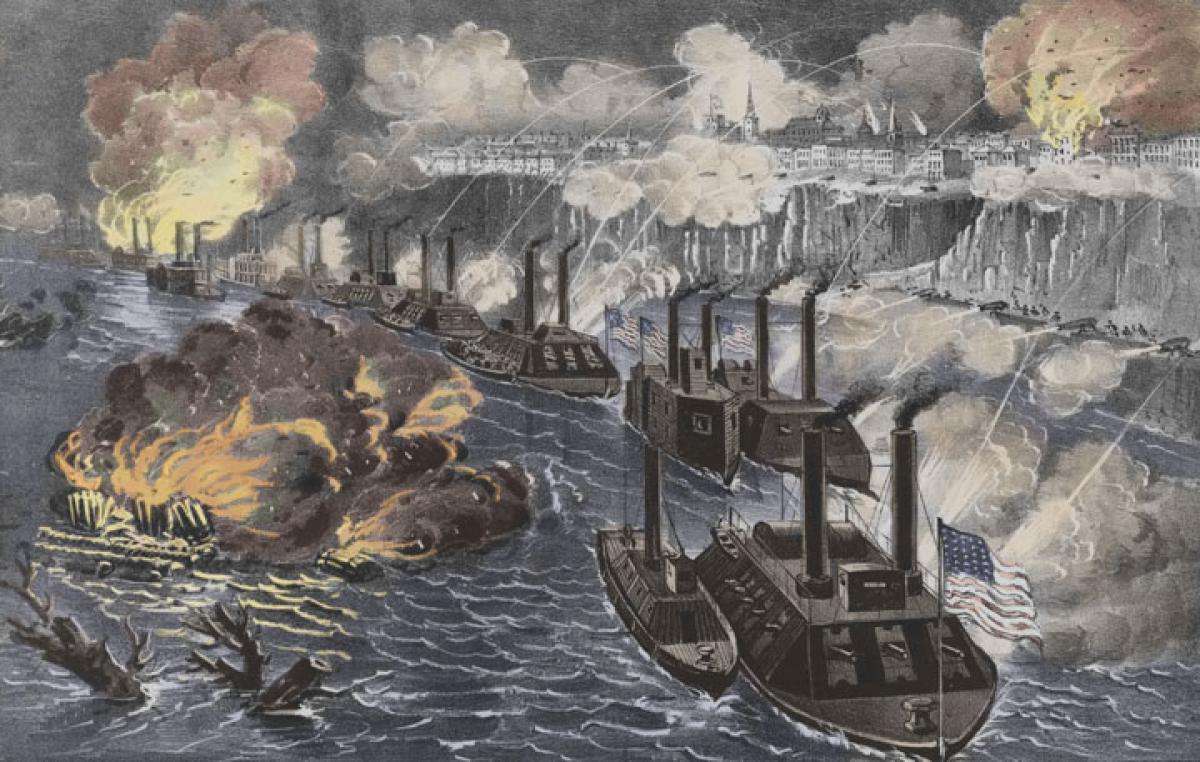Major General Ulysses S. Grant stood over maps searching for answers. For months he had studied them, conferred with subordinates, undertaken personal reconnaissances and endured failures. Questions had arisen about his sobriety, with the War Department sending an observer to his headquarters. Despite the frustrations and controversies, he had assured his wife: “Vicksburg will be a hard job. I expect to get through it successfully however.”
It had been nearly two years since Confederate forces had closed the Mississippi River to Union shipping. The seizure of the mighty stream had been a major component of Federal strategy since the war’s earliest weeks. Citizens of the old Northwest Territory states had urged operations to clear their historic avenue of commerce. Although New Orleans had fallen to Union troops in April 1862, the Mississippi remained closed as long as the cannons at Vicksburg, Miss., swept its waters.
Sitting on a bluff on the river’s eastern bank and shielded to the north by a maze of swamps, bayous and bluffs, Vicksburg posed a multitude of problems to Union planners. Twice during December 1862, Grant ordered thrusts against the city from the north. A movement into central Mississippi ended when Southern cavalrymen captured the Federals’ supply base at Holly Springs. The second advance resulted in a bloody repulse at Chickasaw Bayou, north of Vicksburg.
The Union general had determined after the December failures to march his army down the Louisiana side of the river south of Vicksburg and then ferry it across to the east bank. The endeavor would be difficult and risky, requiring Rear Adm. David Dixon Porter’s fleet to pass by Vicksburg’s heavy guns.
In turn, the Federal army would have to march south over poor roads and await the arrival of the transports. A favorable landing site on the east bank would have to be located, while other operations would be necessary to distract the Confederates.
While Grant continued planning and waited for the roads to dry out, he kept the troops at work digging a canal. Upstream from Vicksburg, the river bent north in a broad loop before turning south again, forming a peninsula opposite the city. The effort to channel the river away from the defenders’ cannons had been underway for weeks. But it held little chance of success and was eventually abandoned.
In early March, Grant wired General-in-Chief Henry W. Halleck, “I will have Vicksburg this month or fail in the attempt.” He ordered operations on the Yazoo River and through Steele’s Bayou, both of which ended in failure. Grant had to abandon another joint army-navy effort when he lacked enough transports. “I am very well but much perplexed,” he admitted to his wife. “Heretofore I have had nothing to do but fight the enemy. This time I have to overcome obstacles to reach him.”
When Grant finally presented his plan to his senior officers, Maj. Gen. William T. Sherman voiced opposition to it. The XV Corps commander argued that Porter’s gunboats and transports could not run past Vicksburg’s batteries. Sherman advocated a withdrawal of the army to Memphis, where it could regroup and then move south. Grant rejected any idea of a retreat. Sherman once said, “Grant is brave, honest, & true, but not a Genius.”
On the night of April 16, with Grant watching from a transport, Porter’s fleet of gunboats, steamers and barges successfully ran the Confederate batteries, losing only one transport to Southern fire. The next day, Colonel Benjamin Grierson and 1,700 troopers started on a mounted raid through central Mississippi to destroy railroad tracks and mislead the Southerners. Sherman’s troops, meanwhile, demonstrated against the city’s northern defenses.
On the Mississippi’s west bank, Maj. Gen. John A. McClernand marched his XIII Corps and two divisions from Maj. Gen. James B. McPherson’s XVII Corps south to Hard Times, La., opposite Grand Gulf, the planned crossing point. Porter’s gunboats arrived and began shelling the defenses. The Confederates hammered the fleet, preventing a crossing.
Grant had come south on a transport and learned from a local black man that Bruinsburg, Miss., a few miles downriver, offered a favorable place for Federal forces to land. On April 30, Porter’s gunboats passed Grand Gulf’s guns and began ferrying McClernand’s infantry and artillery across the river. The next day, the Federals swept aside a Confederate force at Port Gibson, ensuring a firm Union foothold on the Mississippi River’s eastern bank.
After months of frustration, criticism and failure, Grant had executed a brilliant maneuver. Ahead of him lay the capital at Jackson, and then Vicksburg.
In his memoirs Grant wrote of that signal achievement: “When this was effected, I felt a degree of relief scarcely ever equaled since….I was on dry ground on the same side of the river with the enemy. All the campaigns, labors, hardships and exposures from the month of December previous to this time that had been made and endured, were for the accomplishment of this one object.” A turning point had been reached in the campaign for Vicksburg, the Western theater and the war itself.
Originally published in the July 2006 issue of Civil War Times. To subscribe, click here.





